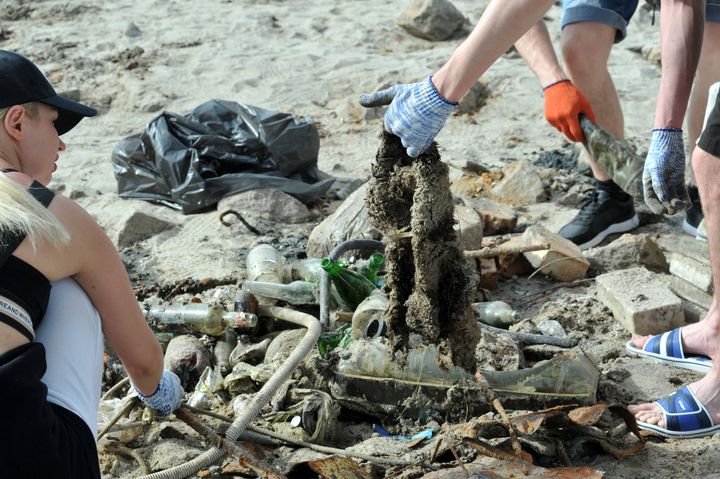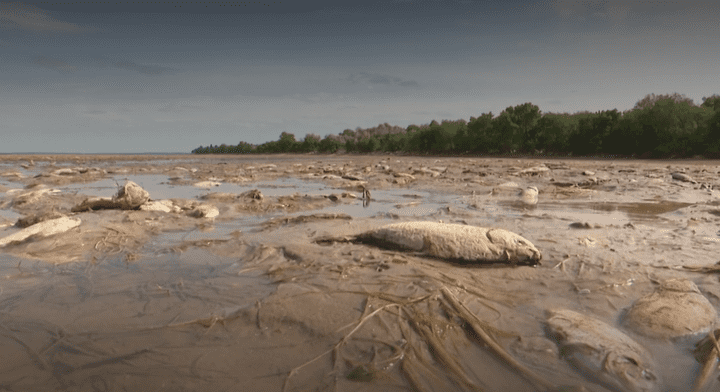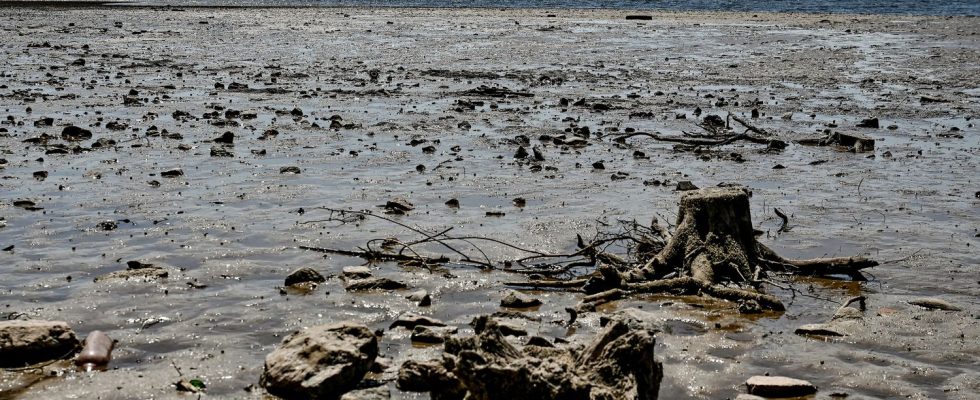Upstream, the fresh water gives way to an expanse of fragrant mud, redrawing an entire region.
While downstream of the dam is flooded, an immense artificial sea is reduced to a trickle. After the destruction of the Kakhovka dam, the inhabitants living upstream of the structure discover a unique landscape of mud banks.
>> War in Ukraine: what is the scale of the ecological disaster after the explosion of the Kakhovka dam?
The level of the reservoir fell by 3.5 meters in the three days following the explosion, according to Theia project data, then two meters each day. A week after the dam broke on Tuesday June 13, the reservoir had lost 72% of its water, according to the company Ukrhydroenergo. On the central beach of Zaporijjia, residents, equipped with metal detectors, are trying to unearth hypothetical buried treasures.

The falling waters have already revealed the remains of a temporary wooden bridge, reports Khortytsia Nature Reserve. This had been built in 1944 by the Red Army after the withdrawal of the German army from the West Bank.
heaps of rubbish
More frequently, it is the waste that is now flush with the surface. In Zaporijjia, residents have organized collections to clear the shore of heaps of rubbish.


In the Nikopol sector, a little further south, the Ukrainian journalist Denis Kazanskiï shared other findings : old weapons and skulls of German soldiers, which seem to date from the Second World War, when the surroundings were the scene of fierce battles.

The city is located about ten kilometers from Enerhodar, which hosts the nuclear power plant in the Zaporijjia region. The sandbanks multiply and give the illusion of a desert space. “The level of the river [Dnipro] drops every day. We were up to eight meters deep, look: there are only puddles of water left”explains a couple met by a franceinfo team.
>> REPORT. “Chernobyl, next door, it’s a toy”: residents of the Zaporijjia power plant worried after the destruction of the Kakhovka dam
The local authorities, however, have forbidden the inhabitants to move on the dry banks and to practice leisure activities there.

The recorded water level in Nikopol was about 17.3 meters before the destruction of the dam. Four days later, on Saturday, he was down to 10.55 meters, then at 9.04 meters on Monday. Since then, the level has been so low that the sensors of the company Ukrhydroenergo are unable to measure it, explains the Ministry of the Environment.
Experts are looking for new ways to monitor its evolution, as the river gradually returns to its original bed, before the dam was built in the 1950s.
Drinking water is running out
Satellite observations show the extent of the disaster. The animated image below compares the situation between June 5, the day before the destruction of the dam, and June 13. The town of Nikopol is located on the visible point on the northern shore, and the nuclear power plant is directly opposite, with its rectangular retention basin. The destruction of the dam, one of six designed in Soviet times on the Dnipro River, led to uncontrollable consequences. On Monday, the reservoir had already lost 14.4 cubic kilometers of water, out of the initial 19, the Ukrainian environment ministry said on Telegram.

This programmed death directly affects the water supply of several cities. In Nikopol, there is no more water at the tap, because the pumps no longer manage to take it from the reservoir. The inhabitants are now supplied by tank trucks, and the queues are increasing in front of the 169 distribution points, detailed on Telegram the gregional governor of Dnipropetrovs.

In Kryvyi Rih, 70 kilometers further northwest, “industrial companies have already reduced their consumption to the strict minimum”wrote on June 11 on Telegram Oleksandr Vilkoul, in charge of the local military administration, last Sunday. Water was rationed four hours a day in several villages. The manager asked the population of the city to reduce their consumption by 40%. In total, 300,000 Ukrainians have already been deprived of drinking water since the destruction of the dam.
>> VIDEO. War in Ukraine: after the explosion of a dam, the country faces a shortage of water
Many species of birds and fish, on the other hand, are already suffering from the transformation of their environment. Eventually, finally, the water deficit will be compensated by an influx of salt water in the estuary of the Dnipro river. “Inevitably, this will destroy most native species of freshwater flora and fauna.”explained to franceinfo the Ukrainian hydrologist Yevhen Korzhov.

This development also threatens agricultural activities, as it there will not be enough water for the irrigation canals usually fed by the reservoir, explained Roger Falconer, a water engineer at Cardiff University, in a journal article Nature. “It could affect both downstream and upstream cultures.”
To make matters worse, the reservoir supplies not only the outlying territories, but also the North Crimean Canal. In total, between 1.5 and 2 million tonnes of cereals are now “at risk”, estimated the analysis Maxence Devilliers, quoted by AFP. Some plots, devastated by the floods, will not be able to be harvested, and others will be deprived of irrigation this summer. “It will take between three and seven years to restore irrigation” throughout the region, has warned Ukrainian Minister of Agriculture, Mykola Solskiy, referring to “a problem for many years.”

